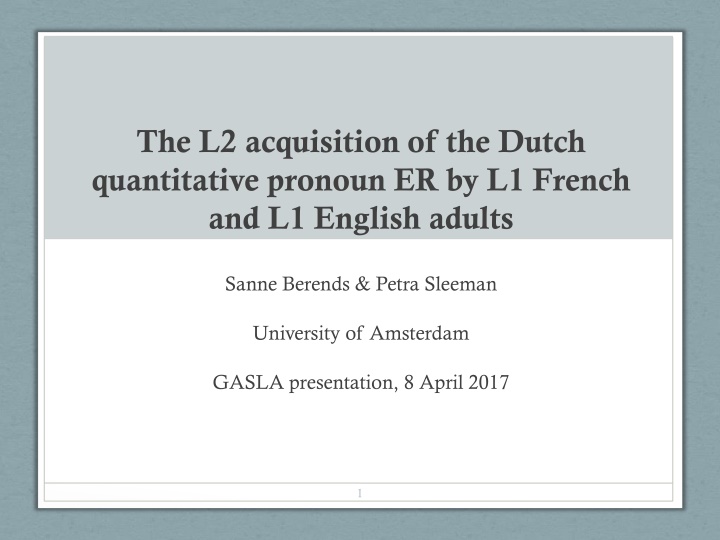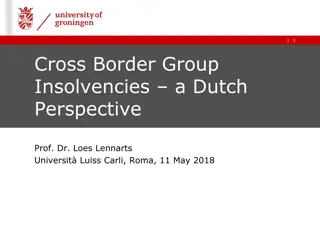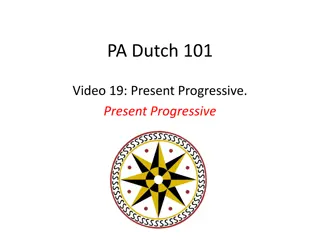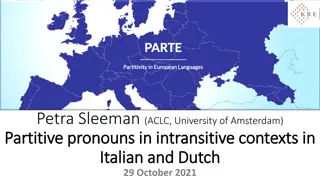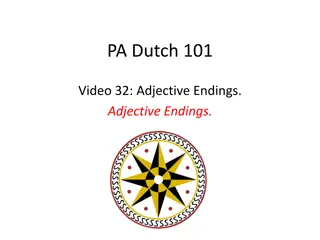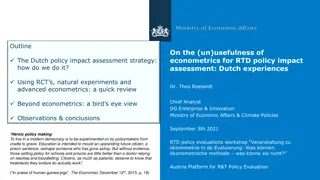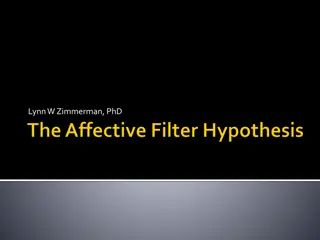Cross-Linguistic Influence on L2 Acquisition of Dutch Quantitative Pronoun "ER
This study examines the L2 acquisition of the Dutch quantitative pronoun "ER" by L1 French and L1 English adults. It explores the syntax and semantics of using "ER" with quantifiers in Dutch, French, and English, analyzing potential cross-linguistic influences on sentence acceptance. The research highlights the distinctions in using "ER" with indefinite versus definite quantifiers across languages.
Download Presentation

Please find below an Image/Link to download the presentation.
The content on the website is provided AS IS for your information and personal use only. It may not be sold, licensed, or shared on other websites without obtaining consent from the author.If you encounter any issues during the download, it is possible that the publisher has removed the file from their server.
You are allowed to download the files provided on this website for personal or commercial use, subject to the condition that they are used lawfully. All files are the property of their respective owners.
The content on the website is provided AS IS for your information and personal use only. It may not be sold, licensed, or shared on other websites without obtaining consent from the author.
E N D
Presentation Transcript
The L2 acquisition of the Dutch quantitative pronoun ER by L1 French and L1 English adults Sanne Berends & Petra Sleeman University of Amsterdam GASLA presentation, 8 April 2017 1
Introduction Object pronoun Ik zie bloemen Ik zie ze I see flowers I see them I see flowers I see them 2
Introduction Object pronoun Ik zie bloemen Ik zie ze I see flowers I see them I see flowers I see them Quantitative pronoun Ik zie vijf bloemen Ik zie er vijf I see five flowers I see er five I see five flowers I see five 3
French, English, Dutch Dutch er I pick five Ik pluk ER vijf French en I pick five J EN cueille cinq English I pick five L1 French, L1 English, L1 Dutch Language of testing: Dutch 4
Results syntax Dutch er I pick five Ik pluk er vijf *Ik pluk vijf French en I pick five J en cueille cinq * Je cueille cinq English I pick five Prediction L1 French positive transfer L1 English negative transfer 5
Results syntax * DU-FR ** DU-EN Condi on:? Presence? 100%? 90%? 80%? 70%? 60%? 50%? 40%? 30%? 20%? 10%? 0%? L1? Dutch? L1? French? L1? English? 6
This presentation We look at semantics We look at GJT and SI Same languages: L1 French, L1 English, L1 Dutch Research question: is there cross-linguistic influence (L1 French and L1 English, L2 Dutch) of the type of quantifier on the acceptance of sentences with q-ER? 7
Semantics (1) Dutch: q-ER can only appear together with pure indefinite quantifiers and not with definite quantifiers. Two subcategories: 1) indefiniteness of the quantifier 1) 2) Dutch Dutch ER + een groot aantal * ER + de helft 1) 2) French French EN + un grand nombre EN + la moiti 8
Semantics (2) Dutch: q-ER can only appear together with pure indefinite quantifiers and not with definite quantifiers. Two subcategories: 2) non-presuppositionality of the quantifier 1) 2) Dutch Dutch ER + enkele * ER + sommige 1) 2) French French EN + quelques-uns EN + certains 9
ER versus ERVAN Dutch er *Ik heb ER de helft/sommige gelezen Ik heb de helft/sommige gelezen Ik heb de helft/sommige ERVAN gelezen Ik heb ER de helft/sommige VAN gelezen French en J EN ai lu la moiti / certains 10
Predictions definiteness Dutch er I pick a lot I pick half Ik pluk er een groot aantal * Ik pluk er de helft French en I pick a lot I pick half J en cueille un grand nombre J en cueille la moiti English I pick a lot / half Prediction L1 French L1 English indefinite definite indefinite definite positive negative negative positive 11
Predictions presuppositionality Dutch er I pick a few I pick some Ik pluk er enkele * Ik pluk er sommige Frenchen English I pick a few I pick some J en cueille quelques-uns J en cueille certaines I pick a few / some Prediction L1 French L1 English non pres pres non pres pres positive negative negative positive 12
Methodology Test Battery - Grammaticality Judgement Task (80 accurate and erroneous sentences of 8 sub conditions; 40 distractors) - Sentence Imitation Task (32 accurate and erroneous sentences of 8 sub conditions; 10 distractors) 13
Methodology Test Battery - Grammaticality Judgement Task (80 accurate and erroneous sentences of 8 sub conditions; 40 distractors) - Sentence Imitation Task (32 accurate and erroneous sentences of 8 sub conditions; 10 distractors) L1 French (25) L1 English (25) L1 Dutch (25) Mean Age 47;0 48;11 32;5 Length of Residence 22;1 19;7 from birth 14
Results definiteness GJT Condition: Definiteness of Q (definite) Condition: Definiteness of Q (indefinite) 100% 100% 90% 80% 80% 70% 60% 60% 50% 40% 40% 30% 20% 20% 10% 0% 0% L1 Dutch L1 French L1 English L1 Dutch L1 French L1 English DU-FR (0.26) DU-EN (0.32) EN-FR (0.97) DU-FR (0.36) DU-EN (0.89) EN-FR (0.29) 15
Results definiteness SI Condition: Definiteness of Q (definite) Condition: Definiteness of Q (indefinite) 100% 100% 80% 80% 60% 60% 40% 40% 20% 20% 0% 0% L1 Dutch L1 French L1 English L1 Dutch L1 French L1 English DU-FR (2.18e-05 ***) DU-EN (3.83e-09 ***) EN-FR (0.02 *) DU-FR (0.08448) DU-EN (0.16154) EN-FR (0.375700) 16
Results presuppositionality GJT Condition: Presuppositionality (non-pres) Condition: Presuppositionality (pres) 100% 100% 80% 80% 60% 60% 40% 40% 20% 20% 0% 0% L1 Dutch L1 French L1 English L1 Dutch L1 French L1 English DU-FR (0.87) DU-EN (0.52) EN-FR (0.56) DU-FR (0.02 *) DU-EN (0.23) EN-FR (0.25) 17
Results presuppositionality SI Condition: Presuppositionality (non-pres) Condition: Presuppositionality (pres) 100% 100% 80% 80% 60% 60% 40% 40% 20% 20% 0% 0% L1 Dutch L1 French L1 English L1 Dutch L1 French L1 English DU-FR (7.25e-10 ***) DU-EN (1.11e-13 ***) EN-FR (0.0203 *) DU-FR (0.17) DU-EN (0.57) EN-FR (0.07) 18
Discussion French: some positive and hardly any negative cross- linguistic influence in semantic conditions English: cross-linguistic influence in most of the semantic conditions More cross-linguistic influence from L1 English than from L1 French Cross-linguistic influence from English in all of the four conditions in the SI, cross-linguistic influence from French only occurred in the GJT. 19
Conclusion On the basis of semantic constructions we found that Cross-linguistic influence is most likely to occur if a language does not have a quantitative pronoun > so more in L1 English than in L1 French. Cross-linguistic influence from L1 English occurred mainly in SI, while cross-linguistic influence from French mainly occurred in GJT. 20
References Berends, S, Hulk, A & Sleeman, P (2016). The emergence of the pronouns Dutch er and French en in child L1 and the role of complexity. Language Sciences. Cardinaletti, A., Starke, M., 1999. The Typology of Structural Deficiency. A Case Study of the Three Classes of Pronouns. In: van Riemsdijk, H. (Ed.), Clitics in the Languages of Europe, Mouton-De Gruyter, Berlin, pp. 145-233 Gondret, P. (1976). Quelques", "plusieurs", "certains", "divers" : e tude se mantique, Le Franc ais Moderne, 44, pp. 143-152. Hoop, H. de. (1995). On the characterization of the weak-strong distinction. In Quantification in Natural Languages, eds. Emmon Bach, Eloise Jelinek, Angelika Kratzer and Barbara H. Partee, 421-450. Dordrecht: Kluwer. Hoop, Helen de. & Kas, M. (1989). Sommige betekenisaspecten van enkele kwantoren, oftewel: enkele betekenisaspecten van sommige kwantoren, TTT 9, 31- 49 Sleeman, P. & Hulk, A. (2013). L1 acquisition of noun ellipsis in French and in Dutch. Romance Languages and Linguistic Theory 2011: Selected papers from Romance' Utrecht 2011, 5, 249. 'Going 21
Thank you S.Berends2@uva.nl A.P.Sleeman@uva.nl 22
